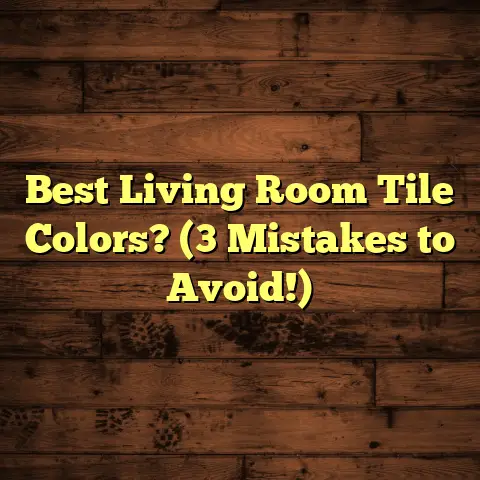Wood Floor Water Damage: Stop It! (8 Fixes Now!)
Beautiful, warm, inviting – wood floors are a dream, right?
But they have a kryptonite: water.
And trust me, water damage can turn that dream into a costly nightmare faster than you can say “insurance claim.”
The good news?
It doesn’t have to be that way. Protecting your wood floors from water damage is totally achievable, and often, it’s about small, consistent changes.
Think of it like this: a little prevention goes a long, long way.
That’s why I’ve put together this guide.
My goal is simple: to arm you with eight actionable fixes you can easily implement to prevent and mitigate water damage.
No complicated jargon, no impossible tasks.
Just practical advice based on years of seeing what works (and what definitely doesn’t!).
Ready to dive in and protect your investment? Let’s do it!
Section 1: Understanding Wood Floor Water Damage
Okay, so what exactly are we talking about when we say “wood floor water damage?”
Simply put, it’s any damage to your wood floors caused by excessive moisture.
This can come from a variety of sources:
- Spills: Obvious, right? A dropped glass of water, a pet accident – these are common culprits.
- Leaks: Think leaky pipes, dripping faucets, even a roof leak can wreak havoc.
- Humidity: This is a sneaky one. High humidity levels, especially in bathrooms and basements, can slowly but surely damage your floors over time.
- Flooding: The worst-case scenario, but even minor flooding can cause significant damage.
But how does water actually damage wood?
Well, wood is a natural material, and it’s porous. That means it absorbs water.
When wood absorbs water, it expands.
Then, as it dries, it contracts.
- Warping: The boards start to curve and become uneven.
- Buckling: The boards lift up from the subfloor.
- Discoloration: Water stains can leave unsightly marks.
- Mold Growth: This is a big one! Mold loves damp environments, and water-damaged wood is the perfect breeding ground.
Ignoring water damage isn’t just about aesthetics.
It can lead to serious structural issues, weakening the subfloor and even affecting the integrity of your home.
Plus, mold growth can cause a range of health problems, from allergies to respiratory issues.
Real Talk: I once had a client who ignored a small leak under their sink for months. By the time they called me, the damage had spread throughout the kitchen, requiring a complete floor replacement and mold remediation. It was a costly and stressful experience they could have avoided with a little preventative action.
Section 2: Assessing Your Floors
Alright, let’s get practical.
Before we can fix anything, we need to assess the situation.
Grab a flashlight and let’s become floor detectives!
Here’s a simple assessment process:
- Visual Inspection: Start by walking around your house and visually inspecting your wood floors. Look for any obvious signs of water damage, like discoloration, warping, or buckling.
- Touch Test: Run your hand over the floors. Do you feel any soft spots? These could indicate water damage beneath the surface.
- Smell Test: Sniff around. A musty odor is a telltale sign of mold growth.
- Check Problem Areas: Pay special attention to areas prone to water exposure, like bathrooms, kitchens, entryways, and basements.
- Look for Gaps: Examine the spaces between the boards. Are there any unusually large gaps? This could be a sign of expansion and contraction due to water damage.
Here’s a handy checklist to guide you:
- [ ] Discoloration or staining
- [ ] Warping or buckling
- [ ] Soft spots
- [ ] Visible mold or mildew
- [ ] Musty odor
- [ ] Gaps between boards
- [ ] Water stains on baseboards
Pro Tip: Document your findings! Take pictures and make notes of any areas of concern. This will be helpful when planning repairs or preventative measures.
My Experience: I always tell my clients to start with the areas they use the most. You’ll be surprised at how quickly you can spot potential problems when you’re actively looking.
Section 3: Prevention Fix #1: Seal Your Floors
Think of sealing your wood floors as giving them a superhero shield against moisture.
A good sealant creates a protective barrier that prevents water from penetrating the wood, minimizing the risk of damage.
There are several types of sealants available, each with its own pros and cons:
- Polyurethane: This is a popular choice for its durability and water resistance. It’s available in oil-based and water-based formulas.
- Oil-based polyurethane is more durable but has a strong odor and takes longer to dry.
- Water-based polyurethane is low-VOC, dries quickly, and has less odor, but may not be as durable as oil-based.
- Oil-Based Sealants: These penetrate the wood, providing a natural look and feel. They offer good water resistance but require more maintenance.
- Water-Based Sealants: These are eco-friendly and easy to apply, but may not be as durable as oil-based options.
How to Seal Your Floors (DIY Style):
- Preparation is Key:
- Thoroughly clean the floors to remove any dirt, dust, or debris.
- Sand the floors to create a smooth surface for the sealant to adhere to.
- Vacuum up any sanding dust.
- Application:
- Apply the sealant using a brush, roller, or applicator pad, following the manufacturer’s instructions.
- Apply thin, even coats to avoid drips and puddles.
- Drying Time:
- Allow the sealant to dry completely between coats, following the manufacturer’s recommended drying time (usually 4-24 hours).
- Apply multiple coats for maximum protection (usually 2-3 coats).
Important Note: Always wear appropriate safety gear, including gloves, a mask, and eye protection, when working with sealants.
My Recommendation: For high-traffic areas or areas prone to moisture, I recommend using a high-quality polyurethane sealant. It’s a worthwhile investment in the long-term protection of your floors.
Section 4: Prevention Fix #2: Control Humidity
Humidity is the silent enemy of wood floors.
Excessive humidity can cause wood to swell, warp, and even develop mold.
Maintaining optimal indoor humidity levels is crucial for preventing water damage.
So, what’s the ideal humidity range for wood floors?
According to the National Wood Flooring Association (NWFA), the ideal range is between 30% and 50%.
Here are some tips for controlling humidity:
- Use a Dehumidifier: Dehumidifiers remove excess moisture from the air, helping to maintain optimal humidity levels. This is especially important in basements and other damp areas.
- Air Conditioning: Air conditioners also help to remove moisture from the air, especially during hot and humid months.
- Proper Ventilation: Ensure proper ventilation in bathrooms and kitchens to remove excess moisture after showering or cooking. Use exhaust fans and open windows when possible.
- Monitor Humidity Levels: Use a hygrometer to monitor humidity levels in your home. This will help you identify when you need to take action to control humidity.
Real-World Example: I had a client who lived in a coastal area with high humidity. Their wood floors were constantly warping and buckling. After installing a whole-house dehumidifier, they saw a significant improvement in the condition of their floors.
Pro Tip: Invest in a digital hygrometer. They’re inexpensive and provide accurate readings. Keep an eye on the humidity levels, especially during seasonal changes.
Section 5: Prevention Fix #3: Install Mats and Rugs
Think of mats and rugs as your first line of defense against water damage.
They act as barriers, absorbing spills and preventing water from reaching your wood floors.
Here are some tips for choosing the right mats and rugs:
- Entryways: Place mats at all entryways to trap dirt, debris, and moisture from shoes. Choose mats with a non-slip backing to prevent accidents.
- Kitchens: Use rugs in front of sinks and dishwashers to catch spills and splashes. Look for rugs that are water-resistant and easy to clean.
- Bathrooms: Place mats in front of showers and tubs to absorb water and prevent slips. Choose mats that are absorbent and quick-drying.
Material Matters:
- Natural Fibers: Cotton and wool are absorbent but can take a long time to dry.
- Synthetic Fibers: Nylon and polyester are water-resistant and easy to clean.
- Rubber Backing: Provides a non-slip grip and prevents water from seeping through to the floor.
Maintenance is Key:
- Regularly clean mats and rugs to remove dirt, debris, and moisture.
- Wash or vacuum mats and rugs according to the manufacturer’s instructions.
- Replace mats and rugs when they become worn or damaged.
My Go-To: I’m a big fan of using indoor/outdoor rugs in high-traffic areas. They’re durable, water-resistant, and easy to clean. Plus, they come in a variety of styles to match any decor.
Section 6: Prevention Fix #4: Regular Maintenance Practices
Regular cleaning and maintenance are essential for preventing water damage.
Think of it as giving your floors a regular checkup to catch any potential problems early.
Here’s a detailed cleaning routine:
- Daily Sweeping or Vacuuming: Remove dirt, dust, and debris that can scratch and damage the floor’s finish.
- Weekly Damp Mopping: Use a damp mop and a wood floor cleaner to remove surface dirt and grime. Be sure to wring out the mop thoroughly to avoid excessive moisture.
- Promptly Address Spills: Clean up spills immediately to prevent water from seeping into the wood. Use a dry cloth to blot up the spill, then clean the area with a wood floor cleaner.
Choosing the Right Cleaners:
- Avoid harsh chemicals: Use cleaners specifically designed for wood floors. Avoid using bleach, ammonia, or abrasive cleaners, as they can damage the finish.
- pH-Neutral Cleaners: Opt for pH-neutral cleaners to prevent damage to the wood.
- Follow Manufacturer’s Instructions: Always follow the manufacturer’s instructions when using wood floor cleaners.
Frequency of Cleaning:
- High-traffic areas: Clean more frequently, such as daily sweeping and weekly damp mopping.
- Low-traffic areas: Clean less frequently, such as weekly sweeping and monthly damp mopping.
Important Reminder: Never use a steam mop on wood floors! The excessive moisture can damage the wood and cause warping.
Section 7: Prevention Fix #5: Repair Leaks Promptly
Leaks are a major cause of water damage to wood floors.
Even a small, slow leak can cause significant damage over time.
Here are some common sources of leaks:
- Plumbing Issues: Leaky pipes, dripping faucets, and running toilets are common culprits.
- Roof Leaks: Damaged shingles or flashing can allow water to enter your home and damage your floors.
- Appliance Leaks: Leaky dishwashers, washing machines, and refrigerators can also cause water damage.
How to Identify and Repair Leaks Quickly:
- Regular Inspections: Regularly inspect plumbing fixtures, appliances, and roofing for signs of leaks.
- Look for Water Stains: Check for water stains on ceilings, walls, and floors, as these can indicate a leak.
- Listen for Dripping Sounds: Pay attention to any unusual dripping sounds, as this can indicate a leak.
- Repair Leaks Immediately: Repair any leaks as soon as possible to prevent further damage.
- Call a Professional: If you’re not comfortable repairing leaks yourself, call a qualified plumber or roofing contractor.
Pro Tip: Check under sinks and around toilets regularly for signs of leaks. A simple visual inspection can save you a lot of headaches down the road.
My Story: I once caught a small leak under my kitchen sink just in time. A tiny drip was barely noticeable, but I knew it could cause big problems if left unchecked. I tightened a loose connection, and the leak was gone. A quick fix that saved me from potential water damage!
Section 8: Prevention Fix #6: Use Water-Resistant Flooring Options
In areas prone to moisture, like bathrooms and kitchens, consider using water-resistant or waterproof flooring alternatives.
While traditional hardwood is beautiful, it’s not the best choice for these areas.
Here are some popular options:
- Luxury Vinyl Plank (LVP): LVP is a synthetic flooring option that is waterproof, durable, and easy to install. It mimics the look of wood and is available in a variety of styles and colors.
- Laminate Flooring: Laminate flooring is a synthetic flooring option that is water-resistant and durable. It’s less expensive than hardwood and is available in a variety of styles and colors.
- Tile Flooring: Tile is a waterproof flooring option that is ideal for bathrooms and kitchens. It’s available in a variety of materials, including ceramic, porcelain, and stone.
Transitioning Between Flooring Types:
- Use Transition Strips: Use transition strips to create a seamless transition between different flooring types.
- Match Heights: Ensure that the height of the different flooring types is the same to avoid tripping hazards.
- Consider Aesthetics: Choose flooring options that complement each other aesthetically to create a cohesive look.
My Perspective: I often recommend LVP for bathrooms and kitchens. It’s a practical and stylish option that provides excellent water resistance without sacrificing aesthetics.
Section 9: Prevention Fix #7: Professional Installation and Repair
While DIY projects can be rewarding, professional installation and repair are often the best choice for ensuring the long-term integrity of your wood floors.
Benefits of Professional Installation:
- Proper Subfloor Preparation: Professionals ensure that the subfloor is properly prepared before installing new flooring, preventing moisture issues and ensuring a level surface.
- Expert Installation Techniques: Professionals use expert installation techniques to ensure that the flooring is properly installed and sealed, preventing water damage and ensuring a long-lasting finish.
- Warranty Protection: Professional installations often come with warranty protection, providing peace of mind in case of any issues.
Benefits of Hiring Experts for Repairs:
- Accurate Diagnosis: Professionals can accurately diagnose the cause of water damage and recommend the appropriate repairs.
- Effective Repair Techniques: Professionals use effective repair techniques to restore damaged flooring and prevent further issues.
- Underlying Issue Identification: Professionals can identify and fix underlying issues that may not be visible to homeowners, such as plumbing leaks or roof damage.
Finding Reliable Flooring Professionals:
- Ask for Referrals: Ask friends, family, and neighbors for referrals to reliable flooring professionals.
- Check Online Reviews: Check online reviews to see what other customers have to say about potential flooring professionals.
- Get Multiple Quotes: Get multiple quotes from different flooring professionals to ensure that you’re getting a fair price.
- Verify Credentials: Verify that the flooring professional is licensed and insured.
My Advice: Don’t hesitate to call in the pros when you’re dealing with significant water damage. It’s an investment that can save you money and stress in the long run.
Section 10: Prevention Fix #8: Educate Your Household
The final piece of the puzzle?
Educating everyone in your household about the risks of water damage and how to prevent it.
Creating a Household Plan:
- Assign Responsibilities: Assign responsibilities for dealing with spills and leaks.
- Emergency Contacts: Keep a list of emergency contacts, such as plumbers and roofing contractors, readily available.
- Spill Kit: Create a spill kit with absorbent cloths, wood floor cleaner, and other necessary supplies.
The Role of Awareness:
- Prevent Accidents: Educate household members about the importance of being careful around wood floors to prevent spills and accidents.
- Prompt Reporting: Encourage household members to promptly report any spills or leaks to prevent further damage.
- Shared Responsibility: Emphasize that maintaining the beauty and integrity of wood flooring is a shared responsibility.
A Simple Conversation Can Help:
- Explain to your kids why it’s important to wipe up spills immediately.
- Remind your spouse to use a bath mat after showering.
- Encourage everyone to be mindful of potential water hazards.
My Takeaway: A little bit of education can go a long way in preventing water damage. By working together, you can protect your wood floors and keep them looking beautiful for years to come.
Conclusion
So, there you have it! Eight actionable fixes to stop wood floor water damage in its tracks.
Remember, while wood floors are vulnerable to water damage, proactive measures can significantly reduce the risk.
From sealing your floors to controlling humidity, installing mats and rugs to repairing leaks promptly, each fix plays a crucial role in protecting your investment.
Don’t wait until you see signs of water damage to take action.
Start implementing these fixes today to preserve the beauty and integrity of your wood floors for years to come.
Your floors (and your wallet) will thank you!
And hey, if you ever have any questions or need a little extra guidance, don’t hesitate to reach out. I’m always happy to help a fellow homeowner protect their precious wood floors.





